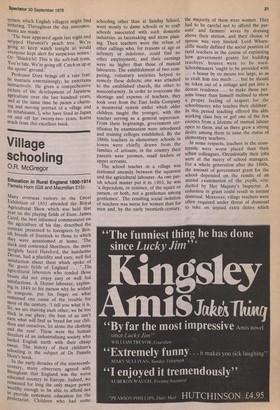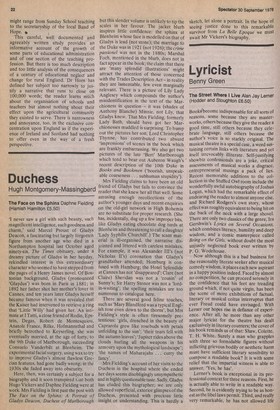Village schooling
O.R. McGregor
Education in Rural England 1800-1914 Pamela Horn (Gill and Macmillan £15) Many overseas visitors to the Great Exhibition of 1851 attended the Royal Agricultural Show which was held that Year on the playing fields of Eton. James Caird, the best informed commentator on the agriculture of his day, described the contrast presented to foreigners by British breeds of livestock to those to which they were accustomed at home. 'The Sleek and contented Shorthorn, the more Sprightly faced Hereford, the handsome Devon, had a placidity and easy, well fed satisfaction about them which spoke of the green fields of England ... ' The agricultural labourers who tended those beasts did not enjoy easy or well fed satisfactions. A Dorset labourer, explaning in 1849 to his parson why he wished to emigrate, put his finger on what remained one cause of the trouble for most of the century. 'I tell you what it is, Sir, we are starving each other; we be too thick in our place; the best of us can't earn what will find us bread for our children and ourselves, let alone the clothing and the rent'. These were the human derelicts of an industrialising society who larded English earth with their cheap sweat. The history of their children's schooling is the subject of Dr Pamela Horn's book.
In the early decades of the nineteenthcentury, many observers agreed with Brougham that England was the worst educated country in Europe. Indeed, we remained for long the only major power wealthy enough to be able to afford not to provide systematic education for the proletariat. Children who had some schooling other than at Sunday School, went mostly to dame schools or to craft schools associated with such domestic industries as lacemaking and straw plaiting. Their teachers were the refuse of other callings who, for reasons of age or infirmity or indolence, could find no other employment; and their earnings were no higher than those of manual labourers. The establishment of two competing, voluntary societies helped to remedy these defects; one was attached to the established church, the other to nonconformity. In order to overcome the shortage and expense of teachers, they took over from the East India Company a monitorial system under which older children taught the younger, with the teacher serving as a general supervisor. From these beginnings, government certificates by examination were introduced and training colleges established. By the 1860s teachers in elementary schools in towns were chiefly drawn from the families of artisans; in the country their parents were yeomen, small traders or upper servants. The school teacher in a village was stationed uneasily between the squarson and the agricultural labourer. As one parish school master put it in 1903, he was 'a dependent, or retainer, of the squire or parson, or both, not a gentleman among gentlemen'. The resulting social isolation of teachers was worse for women than for men and, by the early twentieth-century, the majority of them were women. They had to be careful not to offend the parsons' and farmers' wives by dressing above their station, and their choice of spouse was very limited. Lord Wharncliffe neatly defined the social position of rural teachers in the course of explaining how government grants for building teachers' houses were to be used. Schoolmasters 'ought to be provided with ... a house by no means too large, so as to exalt him too much ... but he should be taken out of a cottage and put into a decent residence ... to make those persons lower than himself inclined to show a proper feeling of respect for the schoolmaster who teaches their children'. In this period teaching offered the able working class boy or girl one of the few escapes from a lifetime of manual labour open to them, and so there grew a strong desire among them to raise the status of elementary teachers.
In some respects, teachers in the countryside were worse placed than their urban colleagues. Occasionally their jobs were at the mercy of school managers. For a whole generation after the 1860s, the amount of government grant for the school depended on the results of an annual examination of the pupils, conducted by Her Majesty's Inspector. A reduction in grant could result in instant dismissal. Moreover, village teachers were often required under threat of dismissal to take on unpaid extra duties which might range from Sunday School teaching to the secretaryship of the local Band of Hope. * This careful, well documented and agreeably written study provides an informative account of the growth of some parts of educational administration and of one section of the teaching profession. But there is too much description and too little analysis of the consequences of a century of educational neglect and change for rural England. Dr Horn has defined her subject too narrowly to justify a narrative that runs to close on 100,000 words; the reader learns much about the organisation of schools and teachers but almost nothing about their effect upon the agricultural community they existed to serve. There is narrowness and annoyance, too, in the exclusive concentration upon England as if the experience of Ireland and Scotland had nothing to offer even in the way of a fresh perspective.



































 Previous page
Previous page